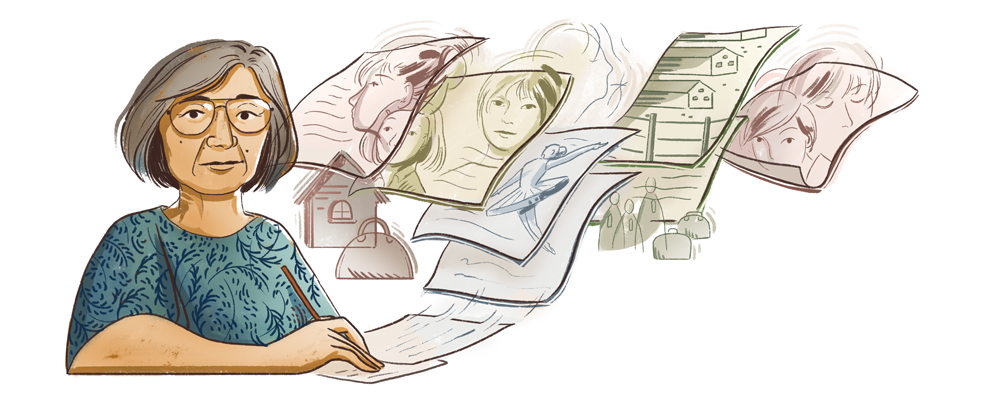
May 04, 2021
Celebrating Hisaye Yamamoto
This Doodle’s Key Themes
In honor of Asian Pacific American Heritage Month, today’s Doodle celebrates Japanese-American short story author Hisaye Yamamoto, among the first Asian Americans to receive post-war national literary recognition. Throughout an acclaimed career, Yamamoto constructed candid and incisive stories that aimed to bridge the cultural divide between first and second-generation Japanese-Americans by detailing their experiences in the wake of World War II.
Born on August 23, 1921, in Redondo Beach, California, Hisaye Yamamoto was the daughter of Japanese immigrant parents. In her teens, Yamamoto wrote articles for a daily newspaper for Japanese Californians under the pen name Napoleon. Following the outbreak of World War II and due to Executive Order 9066, Yamamoto’s family was among the over 120,000 Japanese-Americans forced by the U.S. to relocate to government prison camps (aka Japanese internment camps), where they faced violence and harsh conditions. Despite the injustices encountered daily, she kept her literary aspirations alive as a reporter and columnist for the “Poston Chronicle,” the camp newspaper.
As the dust settled from the war’s end, Yamamoto was released from the internment camp and returned to the Los Angeles area in 1945. Yamamoto soon found work as a columnist with the “Los Angeles Tribune,” a weekly Black-owned and founded newspaper that sought to diversify the voices in journalism and unify the Angelo Black community with Asian Americans.
Over the next three years gathering news for the publication, Yamamoto witnessed firsthand the widespread racism that many underrepresented groups faced. These experiences profoundly changed Yamamoto, who became a literary champion of not just the Asian American community, but for others who also endured discrimination. In 1948, Yamamoto published her first short story, “The High Heeled Shoes,” which inspired Yamamoto to leave journalism and pursue writing full-time, often exploring topics related to the intersection of gender, race, and ethnicity in her works.
The adversity she overcame at the prison camp formed the basis for much of Yamamoto’s work, such as her 1950 short story “The Legend of Miss Sasagawara.” She also remained a life-long advocate in the fight against war, racism, and violence. In 1986, Yamamoto’s storytelling won the Before Columbus Foundation’s American Book Award for Lifetime Achievement for her contributions to American multicultural literature.
Here’s to you, Hisaye Yamamoto!
Listen to Hisaye Yamamoto share what it was like growing up as a second-generation Japanese-American and more about her journey in an exhibit from the American Writers Museum on Google Arts & Culture.
Google is committing more than $10 million to support Asian Pacific Islander (API) organizations in the fight to #StopAsianHate and build safety and equity for the API community.
Learn more, including how you can get involved.
Special thanks to the family of Hisaye Yamamoto for their partnership on this project.
Pictured: Hisaye Yamamoto
Photo credit: Courtesy of the family of Hisaye Yamamoto
Pictured: Hisaye Yamamoto
Photo credit: Courtesy of the family of Hisaye Yamamoto
Pictured: Hisaye Yamamoto
Photo credit: Courtesy of the family of Hisaye Yamamoto
Doodler Q&A with Alyssa Winans
Today’s Doodle was illustrated by Doodler Alyssa Winans. Below she shares her thoughts behind the making of this Doodle:
Q. What does creating a Doodle for Hisaye Yamamoto mean to you personally?
A. Reading Yamamoto's work and working on this Doodle amidst all the recent news about rising violence hit especially hard. It's difficult to see elements of history repeating itself, and my heart goes out to all the individuals and families that have been affected. As someone of mixed background, I have a complex relationship with different aspects of my culture, so I feel honored to be able to work on a Doodle for APAHM. I am always glad to see a space where Asian American and Pacific Islander voices, causes, and culture is elevated and celebrated.
Q. What was your creative development process and inspiration for this Doodle?
A. I started with research, learning as much about Hisaye Yamamoto's life and writing as I could before working on my initial ideas. Her stories felt largely character driven to me, so I tried to bring some of her characters and references to story themes to life in the Doodle.
Q. What stands out most for you from Hisaye Yamamoto's legacy?
A. I'm not an academic, but I personally think her work provides valuable historical snapshots of not only the Japanese internment camps, but of the narratives of Asian American women of her era. It feels like many of her insights into the struggles and decisions her characters face are still relevant today.
Q. What message do you hope people take away from this Doodle?
A. I hope people become interested in learning more about her life and works!
Where this Doodle appeared
Discover more Doodles by color
Did you know?
The very first Doodle launched as an “out of office” message of sorts when company founders Larry and Sergey went on vacation.
Learn MoreDid you know?
The first Doodle launched in 1998, before Google was officially incorporated.
Learn MoreDid you know?
The first same day Doodle was created in 2009 when water was discovered on the moon.
Learn MoreDid you know?
Doodle for Google student contest winners have gone on to become professional artists
Learn MoreDid you know?
The time it takes from sketch to launch for a Doodle varies widely: some have taken years and others just a few hours!
Learn MoreDid you know?
Hundreds of Doodles launch around the world every year. Often, several different ones are live in different places at the same time!
Learn MoreDid you know?
Our most frequently recurring Doodle character is Momo the Cat - named after a real-life team pet!
Learn More